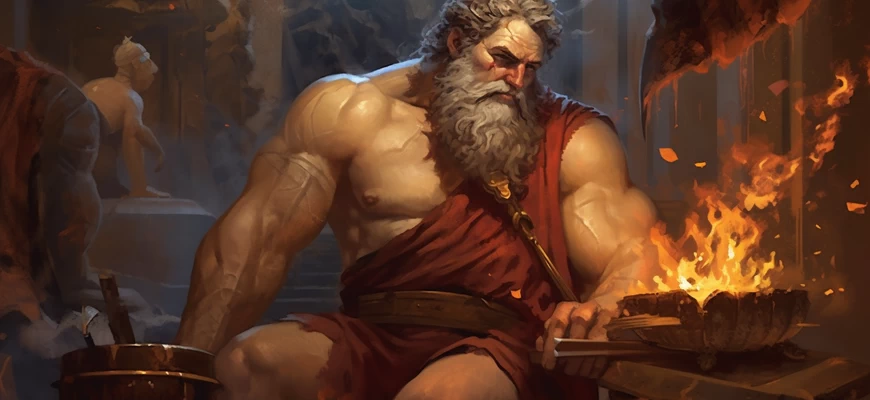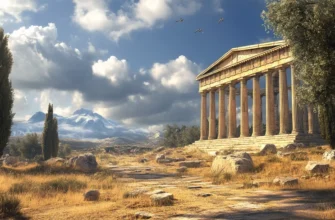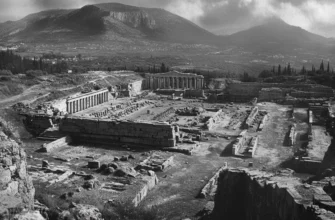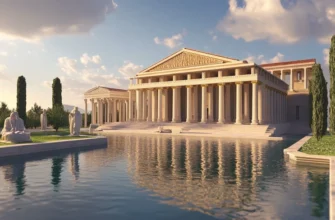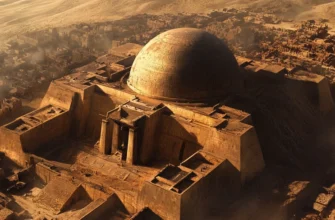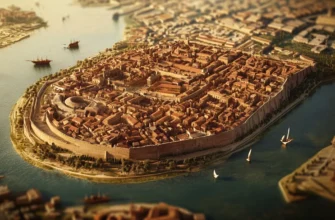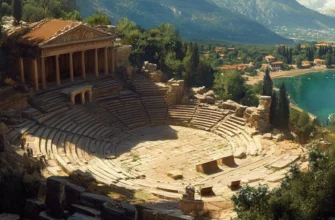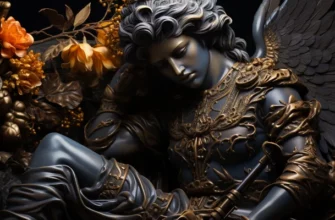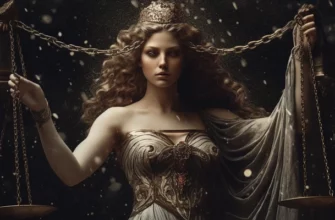Hephaestus is one of the most famous gods in ancient Greek mythology. He was the patron of blacksmiths, fire, and art. His origins are shrouded in mystery, but his skill and strength in working with metal were extraordinary. He controlled fire and was a symbol of craftsmanship and creativity.
Hephaestus played an important role among the Olympian gods. He was not only a renowned blacksmith but also a master of fire. His talent for blacksmithing made him indispensable in the divine ranks. He created powerful weapons and objects for gods and heroes. His creativity and skill also influenced people who revered his art and learned from his experience.
The mythological origin of Hephaestus
The mythological origin of Hephaestus is one of the most interesting stories in ancient Greek mythology. According to legend, Hephaestus was the son of Zeus and Hera, although some versions claim that he was born alone from Hera. His birth was difficult and associated with a conflict between Zeus and Hera.
Zeus, being Hera’s husband, initially rejected Hephaestus because of his physical characteristics — he had a crooked leg. However, later on, Hephaestus became known for his blacksmithing skills, the manufacture of firearms, and his exceptional abilities with fire.
These myths have historically been used to explain Hephaestus’ origins and his unique skills in working with metal and fire. They provide a deep context for Hephaestus’ role in Greek mythology and craftsmanship.
The role of Hephaestus in ancient Greek mythology
Hephaestus played an extremely important role in ancient Greek mythology. He was the patron of blacksmiths, fire, and art. His skill in blacksmithing was considered unmatched, and he crafted powerful weapons for gods and heroes. Hephaestus also controlled fire and controlled furnaces and volcanoes. His presence in mythological tales emphasized the importance of craftsmanship and creativity, as well as his role in maintaining balance in the world of gods and humans.
Attributes and symbols
Hephaestus had his own unique attributes and symbols that were associated with his craftsmanship and fiery characteristics.
Anvil and hammer: Hephaestus’ main attribute, the anvil, symbolized his skill in blacksmithing. He used the hammer to work metal and create weapons and other objects.
Fire and furnace: Fire was one of Hephaestus’ main attributes. He possessed knowledge and control over fire, and his presence in furnaces and volcanoes emphasized his power over this element.
These attributes and symbols not only reflected Hephaestus’ specialization in craftsmanship, but also emphasized his role as the patron of blacksmiths, fire, and art. They also pointed to his influence on the creation of weapons and other useful objects in the world of ancient Greek mythology.
Hephaestus’ place among the Olympian gods
Hephaestus held an important place among the Olympian gods in ancient Greek mythology. He was one of the twelve main Olympian gods and had a permanent place on Mount Olympus, the gathering place of the gods. His role as the patron of blacksmiths, fire, and art earned him great respect among the other gods. He participated in mythological adventures alongside other deities and contributed to important events in the world of gods and humans.
Relationships with other gods
Hephaestus had various relationships with other gods in ancient Greek mythology. His relationships with some of his close deities were particularly interesting:
Zeus: Hephaestus was the son of Zeus, although his birth was unusual. These two gods had a complicated relationship, and in some myths, Zeus rejected Hephaestus because of his physical characteristics.
Hera: As Hephaestus’ mother, Hera also cared for him. However, their relationship was tense, and there were many conflicts between them.
Athena: Athena was Hephaestus’ sister and had a close relationship with him. They often collaborated together in creativity and weapon production.
Hercules: Hephaestus made some weapons for Hercules, including his famous club.
Aphrodite: In some versions of the myths, Aphrodite and Hephaestus were married. However, their relationship was complicated, and Aphrodite often cheated on him with Ares.
These are just a few examples of Hephaestus’ relationships with other gods. In his mythological adventures, he interacted with many other deities, which added an important element to ancient Greek mythology.
The legacy of Hephaestus in the modern world
The legacy of Hephaestus, the ancient Greek god of blacksmiths and craftsmen, is reflected in the modern world through various aspects:
Blacksmithing: The traditions of blacksmithing and metalworking associated with Hephaestus live on in modern blacksmiths and craftsmen. They use techniques rooted in ancient methods to create handcrafted items and metal masterpieces.
Firearms: The idea of Hephaestus as the god of fire and his ability to control fire is reflected in modern processes for manufacturing firearms, furnaces, and other fire-related devices.
Metallurgy and engineering: Hephaestus’s knowledge of metallurgy and engineering is important in the modern world. They are used to develop new materials, production technologies, and create complex engineering structures.
Art and culture: Hephaestus, as the patron of art, influences creativity in other areas of culture, such as sculpture, painting, graphic arts, and design. His influence can be felt in metal sculptures, handicrafts, and art installations.
These elements of Hephaestus’ legacy show that his influence and legends live on in the modern world, recreating his importance as the god of blacksmiths and craftsmen in our culture and creativity.
Characters based on Hephaestus
There are several literary and artistic characters based on Hephaestus, the ancient Greek god of blacksmiths and craftsmen. Here are a few examples:
Hephaestus – a character in Greek mythology who appears in famous myths and episodes. He is depicted as a blacksmith and god of fire who makes weapons for gods and heroes.
Vulcan – a character in Roman mythology who is the equivalent of Hephaestus. Vulcan is also known as the god of fire and blacksmiths, and he makes weapons and objects for the Roman gods.
Tinkerer – a character from Marvel comics. His appearance and blacksmithing skills are inspired by Hephaestus. He is a genius inventor and master craftsman.
These characters reflect the influence and ideas associated with Hephaestus in various literary and artistic works, expanding his legacy and perception in the modern world.
Conclusion
Hephaestus, the ancient Greek god of blacksmiths and craftsmen, played a major influential role in ancient Greek mythology. His origins, role, relationships with other gods, attributes, and symbols had a significant impact on culture, art, and crafts. His legacy is reflected in the modern world through the traditions of blacksmithing, firearms, metallurgy, art, and culture in general. Hephaestus remains a symbol of craftsmanship, creativity, and the ability to control fire, reminding us of the importance of craftsmanship and creativity as an essential part of the world of gods and humans.
